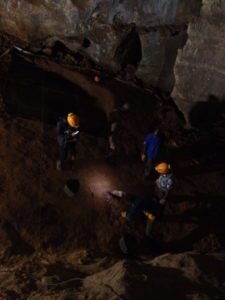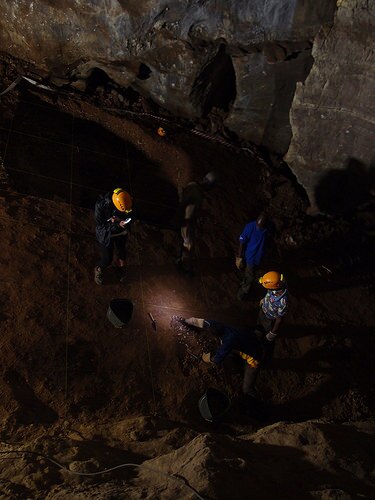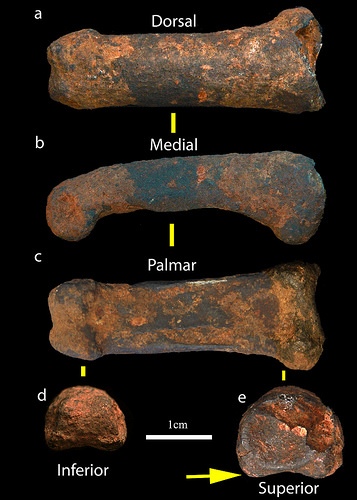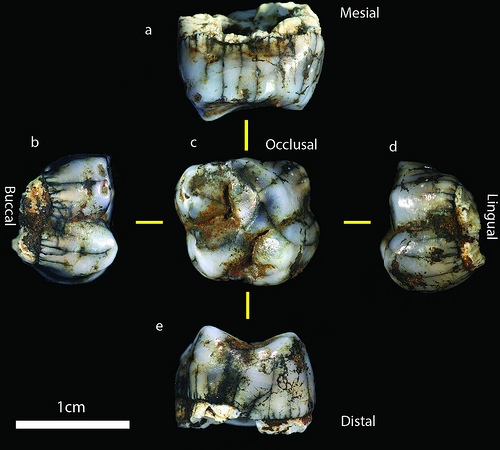 OLYMPUS DIGITAL CAMERA
OLYMPUS DIGITAL CAMERA Two new hominin fossils have been found in a previously uninvestigated chamber in the Sterkfontein Caves, just North West of Johannesburg in South Africa.
The two new specimens, a finger bone and a molar, are part of a set of four specimens, which seem to be from early hominins that can be associated with early stone tool-bearing sediments that entered the cave more than two million years ago. During a second phase of excavation in the Milner Hall—a component of the Sterkfontein Caves—which was started early in 2015 with student Kelita Shadrach, four hominin fossils were excavated from the upper layers of a long sequence of deposits that document the long history of fossil deposition in the caves, starting over 3.67 million years ago.
“The [two] specimens are exciting not only because they are associated with early stone tools, but also because they possess a mixture of intriguing features that raise many more questions than they give answers,” says lead researcher Dr Dominic Stratford, a lecturer at the Wits School of Geography, Archaeology and Environmental studies, and research coordinator at the Sterkfontein Caves.
The first fossil specimen, which is a very large proximal finger bone, is significantly larger and more robust than any other hand bone of any hominin yet found in South African plio-pleistocene sites.
“It is almost complete and shows a really interesting mix of modern and archaic features. For example, the specimen is markedly curved – more curved than Homo naledi and is similarly curved to the much older species Australopithecus afarensis,” says Stratford.
The level of curvature is often linked to arborealism, but it lacks the strong muscle attachments that are expected to be present.
“The finger is similar in shape to the partial specimen from Olduvai Gorge that has been called Homo habilis, but is much larger. Overall, this specimen is unique in the South African plio-pleistocene fossil hominin record and deserves more studies,” says Stratford.
The other fossil is a relatively small, nearly complete adult 1st molar tooth that also has striking similarities to species Homo habilis.
“In size and shape it also bears a resemblance to two of the 10 1st molars of the H.naledi specimens, although further and more detailed comparisons are needed to verify this.”
The shape of the tooth and particularly the shape and relative sizes of the cones on the surface of the tooth suggest this specimen belonged to an early member of the Homo genus and can be associated with early stone tools dated recently to 2.18 million years ago.
“The two other hominin fossils found are still being studied and further excavations are planned to hopefully find more pieces and expand our understanding of who these intriguing bones belonged to and how they lived and died on the Sterkfontein hill more than two million years ago,” says Stratford.
__________________________________________
Researchers exploring Milner Hall in the Sterkfontein Cave for fossils. Courtesy Dominic Stratford
___________________________________________
New hominin finger bone found at the Sterkfontein Cave. Courtesy Jason Heaton
____________________________________________
New hominin molar found at the Sterkfontein Cave. Courtesy Jason Heaton
___________________________________________
The Sterkfontein Legacy
The Sterkfontein Caves have been one of the most prolific palaeoanthropological sites in the world, since the discovery of the first ever adult Australopithecus by Robert Broom, 80 years ago this year. Since this incredible discovery, some of palaeoanthropology’s most famous finds have come from the Sterkfontein Caves, including Ms. Ples and Little Foot.
Sterkfontein remains the richest Australopithecus-bearing locality in the world and continues to yield remarkable specimens. The underground network of caves at the site extends over 5kms and the caves are filled with fossiliferous sediments that have been deposited underground over a period of more than 3.67 million years.
However, very few of these deep deposits have been systematically excavated and so remain largely unknown. The Milner Hall, where the four new hominin fossils were found, is one such chamber where several large deposits have been identified but never excavated.
The excavations that yielded these new hominin fossils were being conducted as part of a series of exploratory excavations away from the known hominin-bearing areas. Excavations in the Jacovec Cavern, Name Chamber and Milner Hall have been started under Dr Stratford’s direction. Each has yielded exciting new fossils that shed further light on the story of our evolution and life on the Sterkfontein hill more than two million years ago.
Source: Edited and adapted from the University of the Witwatersrand press release. Find the study at here.
________________________________________________
In addition, the latest Popular Archaeology ebook is now available.
______________________________________________
Travel and learn with Far Horizons.
____________________________________________
This richly illustrated issue includes the following stories: Two remarkable discoveries that are shedding light on human beginnings in Africa; a traveling exhibit and an archaeological site that show how knowledge is more valuable than gold; a Spanish cave and a unique burial that are offering a tantalizing glimpse on the lives of Ice Age hunter-gatherers in Europe; the stunning visual reconstruction of an ancient Roman town; enlightening new finds at a remarkably well-preserved site of ancient Hellenistic-Roman culture overlooking the Sea of Galilee; rare finds that are shedding light on occult practices among ancient Greeks in Sicily; and an overview of the overwhelmingly rich archaeological heritage of Britain. Find it on Amazon.com.











